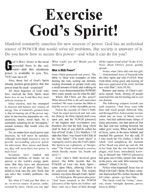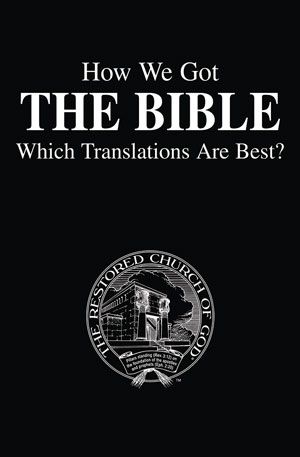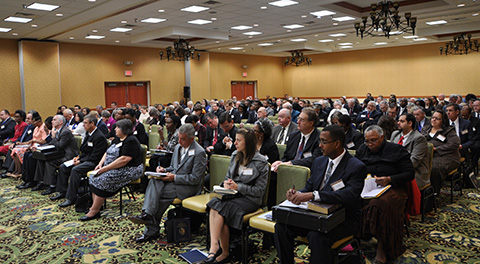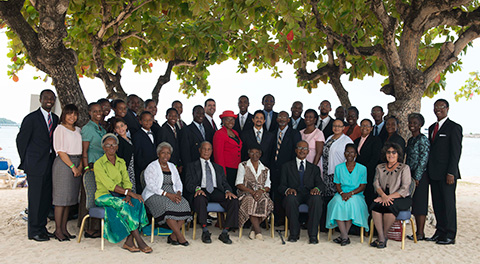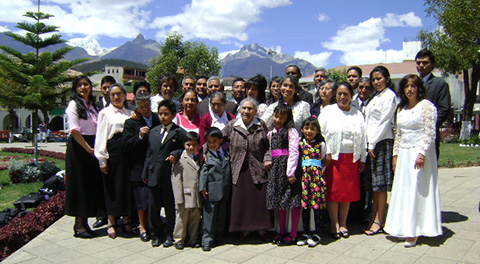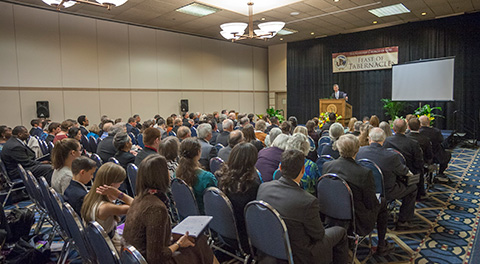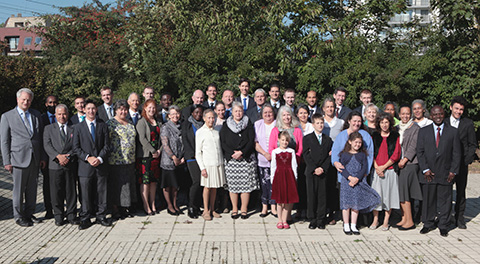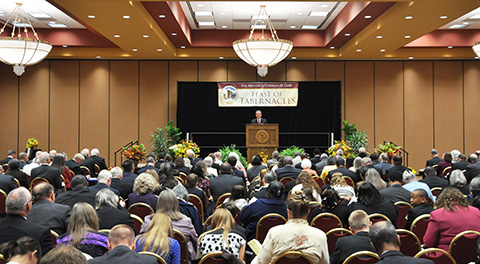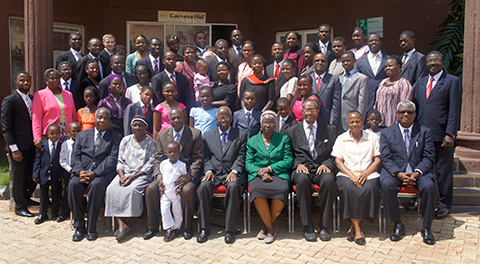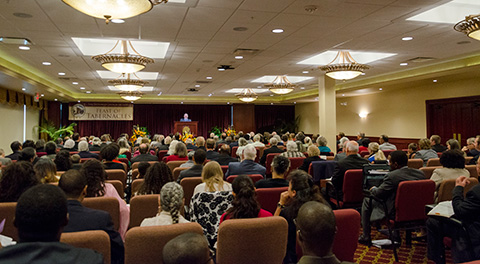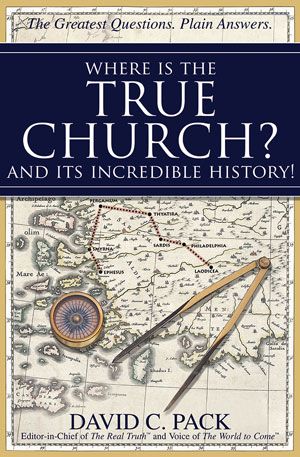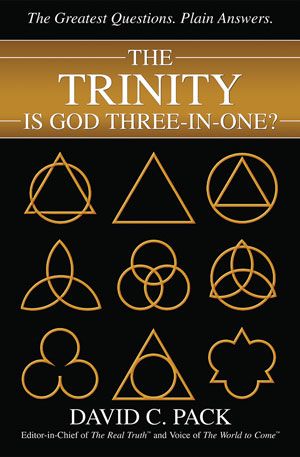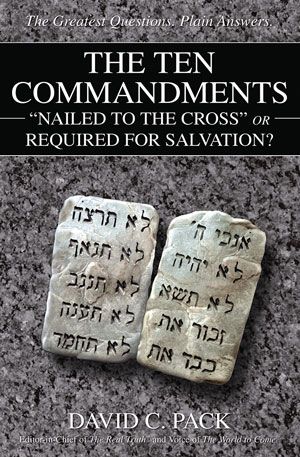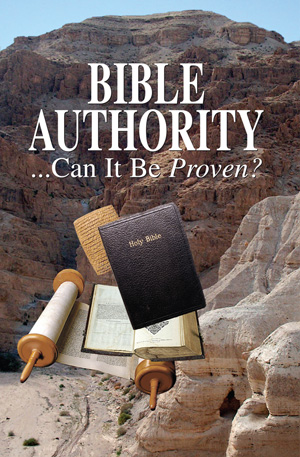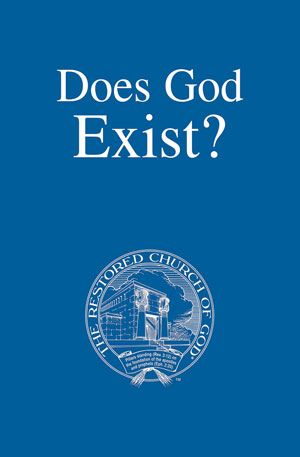Where did the Bible come from? What is the background of its origin? Who authored it? Many wonder: Do we have the entire Bible? Some feel we cannot know. Can this be proven?
Many believe the Catholics assembled the Bible. Is this true? What role did the Jews play in compiling God’s Word?
There are plain answers to these questions.
You need to know if God wrote the Bible—or men did. For instance, it contains many commands that either do or do not have authority behind them. Also, one-third of it consists of prophecies that will affect you—and soon!
Consider for a moment. Are you able to preserve important financial papers that you need to keep? Can families preserve treasured photographs, protected in an album? Are companies able to keep records vital to their existence? Can the National Archives protect priceless documents and artifacts from America’s history? Can courts preserve the record of proceedings? Is the Internet capable of preserving virtually EVERYTHING?
The answer in every case is “Of course!”
If God can create the universe—and all life within it—surely He can preserve His Word. Yet, most seem to think that God is less capable of preserving what is vital to Him than are human beings!
The design and development of the Bible is a fascinating story. This booklet will explore in essential detail the canonization—the binding and confirming—of those books that God intended to preserve for all time as His Word—Scripture.
The Parameters
Three separate areas need to be understood and appreciated to answer the opening series of questions. We will present the overwhelming evidence in the following general format:
(1) The design and layout of the Old Testament (including canonization).
(2) The design and layout of the New Testament (including canonization).
(3) The study of the Apocrypha and other documents not canonized.
Part 1: The Design and Layout of the Old Testament
God gave the Jewish people a special commission. Speaking of Moses, the book of Acts states, “This is he, that was in the Church in the wilderness with the angel which spoke to him in the Mount Sinai, and with our fathers: who received the lively oracles to give unto us” (7:38). Next, notice who exactly was commissioned to preserve the “lively oracles”: “What advantage then has the Jew? Or what profit is there of circumcision? Much every way: chiefly, because that unto them were committed the oracles of God. For what if some did not believe? Shall their unbelief make the faith of God without effect? God forbid: yes, let God be true, but every man a liar...” (Rom. 3:1-4). God commissioned the Jews—their unbelief or not—to preserve His Word.
The oracles of God consist of the Sacred Scriptures and the Sacred Calendar, which includes the seven-day weekly cycle. Some mistakenly reject this calendar—sometimes called the Hebrew calendar—because they insist on looking solely to the Bible for guidance—not anything the Jews did. Yet it was God—not men!—who entrusted the Jews to preserve the calendar and the Scriptures!—the lively oracles! To find the source of the true Scriptures, we must look to the Jews, whose leaders were charged with preserving the Law, Prophets and the Psalms, known as the Old Testament.
Can we be absolutely certain that God preserved His Word for us today—nearly 2,000 years after the final canonization of the New Testament? Christ answers this in Matthew 24:35: “Heaven and earth shall pass away, but My words shall not pass away.”
Notice another statement by Christ that expands on this principle: “Think not that I am come to destroy the law, or the prophets: I am not come to destroy, but to fulfill. For verily I say unto you, Till heaven and earth pass, one jot or one tittle shall in no wise pass from the law, till all be fulfilled” (Matt. 5:17-18).
The phrase, “the law or the prophets,” is a term for the Hebrew Scriptures, as we will see shortly. Christ did not come to destroy God’s Word, or nullify His Law, but to fulfill them—here speaking of prophecies of His Coming and sacrifice for the world. (To learn more about God’s Law, read our book The Ten Commandments – “Nailed to the Cross” or Required for Salvation?)
Notice the following verse, which shows that Jesus knew that the Jews possessed the proper Scriptures, prophesying a specific fulfillment. The setting is the moment He is seized before crucifixion: “But how then shall the scriptures be fulfilled, that thus it must be?…But all this was done, that the scriptures of the prophets might be fulfilled. Then all the disciples forsook Him, and fled” (Matt. 26:54, 56).
Acts 17:10-11 shows where the brethren looked to find the true Scriptures: “And the brethren immediately sent away Paul and Silas by night unto Berea: who coming there went into the synagogue of the Jews. These were more noble than those in Thessalonica, in that they received the word with all readiness of mind, and searched the scriptures daily, whether those things were so.”
The evangelist Timothy, the son of a Jewish woman, had known the true Scriptures from childhood: “From a child you have known the holy scriptures, which are able to make you wise unto salvation through faith which is in Christ Jesus. All scripture is given by inspiration of God, and is profitable for doctrine, for reproof, for correction, for instruction in righteousness” (II Tim. 3:15-16).
Many other verses could be cited to reinforce this fact, but the point is clear. Every synagogue possessed copies—exact replicas—of the texts found in the Temple. Even the term “holy scriptures” literally meant “Sacred Scriptures.” Sacred refers to the Holy Place of the Temple. “Holy scriptures” is actually translated “Temple Scriptures” in the Englishman’s Bible. Again, all the sets of Scriptures in the synagogues were replicas of the texts found in the Temple.
Doubters are essentially accusing God of being incapable of preserving His Word. What about you? Do you accept the Scriptures as authentic—as preserved by the Jews? Did the Jews succeed, or was God’s plan thwarted?
The Arrangement of the Books
The King James Version and virtually all other more modern translations list 39 individual books in the Old Testament. These books do represent the entirety of the Old Testament. But the one problem with them is the order in which they are found.
Since these books constitute the official Hebrew canonized Scriptures, this is where we should look to establish the correct order. First, notice that Christ told His disciples, after His Resurrection, that Bible verses foretold of His life and mission: “And He said unto them, These are the words which I spoke unto you, while I was yet with you, that all things must be fulfilled, which were written in the law of Moses, and in the prophets, and in the psalms, concerning Me. Then opened He their understanding, that they might understand the scriptures” (Luke 24:44-45).
As Luke wrote of this account, he was specifying which Scriptures—the Hebrew canonized Scriptures—Christ pointed out as His inspired Word. They foretold of His life and fulfillment of many prophecies concerning Him.
Luke was specifying this information to the gentile readers of his Greek manuscripts.
The Hebrew canonized Scriptures are emphasized here in contrast to such counterfeit documents as the Septuagint, written in the Greek language. (More will be covered about the Septuagint later.) Accurate and valid copies of the Hebrew Scriptures translated into the Greek language did exist in the first century.
Notice that Christ Himself identified the Hebrew Scriptures by the following terms: (1) The Law of Moses, (2) the Prophets, and (3) the Psalms.
These are the three major divisions of the Hebrew Scriptures—the Old Testament. They were arranged according to the recorded words of Jesus Christ in Luke 24:44-45.
Before defining these three sections in detail, realize that the correct arrangement is different from the King James Version and other modern translations.
This is because the Roman Catholic Church based its Latin Vulgate on the Egyptian Septuagint Version, written in Greek. These largely Samaritan religionists had no commission to preserve the Scriptures. They did not fear the God of Israel, and proceeded to group the Scriptures as they saw fit. They rearranged the order of the Old Testament books according to subject, ignoring the inspired order of the Law, the Prophets and the Psalms.
But it was only the order that the Catholics changed, not the content and not the selection of books. The Catholics did not canonize the Bible! All claims that they did are FALSE!
Most Bible arrangements reflect the rearrangement of these non-Jewish counterfeits. The order of the 39 books is radically changed. Yet we shall see their original placement and come to appreciate why that order was important.
Note what Flavius Josephus, an historian during Jesus’ time, wrote regarding the number of books in the Hebrew Scriptures: “For we (the Jews) have not an innumerable multitude of books among us, disagreeing from and contradicting one another (as the Greeks have), but only 22 books, which contain the records of all the past times; which are justly believed to be divine” (Against Apion, Book I, Section VIII).
Many scholars associated with the Catholic movement also publicly acknowledged there were 22 books in the Hebrew Scriptures: Origen (AD 210), Athanasius (365), Cyril of Jerusalem (386), and Jerome (410).
Here then is the correct order of the Old Testament. We first list the books of the Law, also known as the Torah or Pentateuch:
The Law of Moses (5 books):
Genesis, Exodus, Leviticus, Numbers and Deuteronomy
Note that in this first section of the Law, the order is not changed. The radical changes appear in the second (the Prophets) and third sections (the Psalms or Writings).
Now, we list the original order of the Prophets. Note how books are divided and sub-divided:
The Former Prophets (2 books):
Joshua and Judges (combined into one), I-II Samuel and I-II Kings (all four combined into one)
The Latter Prophets (4 books):
Three major prophets: Isaiah, Jeremiah and Ezekiel (one book each); “The Twelve” prophets (consisting of 12 prophetic books again combined into one): Hosea, Joel, Amos, Obadiah, Jonah, Micah, Nahum, Habakkuk, Zephaniah, Haggai, Zechariah and Malachi
Finally, the third division known as the Psalms. This division is also known as the Writings. It is divided into three parts:
The Former Poetic Books (3 books):
Psalms, Proverbs and Job
The Megillot or Festival Books (5 books):
Song of Solomon, Ruth, Lamentations, Ecclesiastes and Esther
The Latter Restoration Books (3 books):
Daniel, Ezra-Nehemiah (combined into one), I-II Chronicles (combined into one)
This original order is completely chronological. This will be better appreciated later when we study canonization.
The Significance of the Numbers
There is another aspect of the significance of the number 22. Sextus Senensis, a Jewish scholar, AD 1520, is credited with the following statement: “There are 22 [Hebrew] letters, in which all that can be said and written are comprehended, so there are 22 books in which are contained all there can be known and uttered of divine things” (General Introduction to the Old Testament, Green).
With the significance of the 22 books (or scrolls) of the Hebrew Scriptures and the 22 letters of the Hebrew alphabet, a type of an alphabetical “acrostic” most likely paralleled the 22 books. An acrostic exists when 22 verses each begin with a word spelled with a different letter of the Hebrew alphabet. Each letter (beginning with the first) continues in order all through the alphabet in sequence. In other words, the first letter of the alphabet corresponds with the first letter of the first verse. Then the second letter of the alphabet corresponds with the first letter of the second verse, and so on. The parts of an acrostic can be single verses each, or sets of verses, or possibly chapters or even books.
An example of a complete acrostic is Psalm 119. Here, eight verses are grouped together into 22 sets of verses. The first letter of all eight verses of each set is the same letter of the alphabet. Thus the first eight verses begin with the first letter, the next eight verses all begin with the second letter of the alphabet, and so on. Not only is this poetic chapter a perfect and complete acrostic, the syllables of each verse have to perfectly match each other, because it was set to music.
Psalm 119 covers the subject of the Law of God being perfect and complete. Thus, a perfect and complete acrostic is used. Every single verse of this Psalm in the original Hebrew mentions God’s Law, using terms such as law, precepts, judgments, statutes, commandments, etc. The eight verses per stanza or meter, times the 22 letters of the Hebrew alphabet, equals 176. There are precisely 176 verses in Psalms 119.
Together, Psalms 111 and 112 form a complete acrostic showing God will completely redeem His people. Each Psalm contains 10 verses, with the 10th verse of each containing two sections.
The way Bibles are divided into chapters and verses does not always properly coincide with the method or intent with which these were written (see inset). For instance, Proverbs 31:10-31 contains 22 verses forming another complete, perfect acrostic. These verses describe a complete and perfect woman. Another complete acrostic is in Lamentations. This one emphasizes the complete destruction coming on all the 12 tribes of modern Israel.
During Christ’s time, the Hebrew Scriptures consisted of 22 books. (We saw Josephus and others document this.) As a point of interest, when one adds the 22 books of these Scriptures to the 27 books of the New Testament, a total of 49 books results. To the Jews, the number 49 (seven times seven) represents absolute completion.
(Also, another way to count is, if each Old Testament book is counted individually—and the Psalms are counted as five books because of their natural division—the Old Testament total is 43 books. Adding this to the New Testament total of 27 yields the number 70, which is ten times God’s number of completion or perfection.)
By the second century, many Jews came to resent what they thought of as “their” Scriptures being combined with the New Testament to equal 49 books. So they adjusted the order of the Hebrew Scriptures to increase the number to 24. This was done by dividing Joshua/Judges into two books and by dividing Samuel/Kings into two books, giving a new total of 24 books.
While this change gave a different number, the books within divisions were never moved to other divisions.
Before and during this time, the Jews held disgust for the Egyptian Septuagint Version, which totally reshuffled the books of the second and third divisions (the Prophets and Writings).
Again, this is where the Catholics inherited their erroneous order of the Old Testament and passed it on to us today in the same distorted order, through the King James Version and most other versions available today.
Many Hebrew Bibles bear the label TANAK (or often TANAKH) on the cover. This name is derived from the three parts of the Hebrew Scriptures:
TORAH is the name given to the division on the Law of God—first 5 books.
NEBEE-EEM is the name for the Prophets division.
KETHUVEEN is the Writings division.
The initial letters of the three titles (T,N,K) form the word TANAK. Named for these three major divisions, this shows the Jews’ acceptance of the true divisions, as opposed to certain corrupted versions like the Septuagint.
History of Old Testament Canonization
Moses recorded and compiled all five books of the Law (Pentateuch) during Israel’s 40 years in the wilderness. God obviously guided him to use pre-Flood documents and other sources to compile the book of Genesis.
Genesis, Exodus and Leviticus were written during the first years in the wilderness. Numbers was written as the continuous record of the journey. Of course, at the outset, Moses never anticipated the journey would last 40 years. The book of Deuteronomy was written during the very last months of the journey.
Just before his death, Moses presented to the priesthood of Israel the five books he had compiled and written (Deut. 31:9). These were stored in the sides of the Ark of the Covenant. Under authority of the high priest, scribes made copies of these scrolls.
All the kings of Israel were required to copy the entire Pentateuch, or five books of the Law. This precept was added by Samuel and observed by David, Solomon, and later by most of the kings of Judah.
Next, the Book of Joshua/Judges was classified with the prophets primarily because it was written by Samuel, who was a prophet. But this work was primarily historic, and laid the groundwork for the following books of Samuel/Kings and the Latter Prophets. It was Samuel who established the “company of the prophets” throughout Israel (I Sam. 10:5, 10; 19:20).
Certain historic facts from Joshua were likely compiled from sources generated by Joshua and some of God’s loyal servants who came after Joshua. Much of the detailed history of the early kings of Israel and Judah was probably recorded by the prophet Elijah, but later compiled and written by Isaiah for the section of Kings in the Book of Samuel/Kings. After all, who would be more qualified to write about Elijah than Elijah himself?
Elijah carried on with the schools of the prophets in Israel—there were three—that Samuel had inaugurated over 200 years earlier (II Kgs. 2:3, 5; 4:38). One purpose of these schools would have been to document historic events and transcribe previous records to be compiled later into canonized manuscripts. Elisha and others with him contributed to the historic records after the time of Elijah.
Obviously, the books of the major and minor prophets were written by the men to whom the books are attributed. These prophets wrote and sealed their own works, to be added to the Scriptures during subsequent times of canonization.
King David wrote and canonized much of the Psalms. David established the 24 (2-week) courses for the priests, and for the Levites and singers. He wrote two of the five books. These first two books consisted of the first 72 chapters of Psalms, the official Psalms used for the Temple service by the singers.
The Psalms dedicated to Asaph and to Korah were also written by David and dedicated to these outstanding singers. These Psalms would include most of Book 3. Other contributors to the book of Psalms included Moses (author of Psalm 90 and a number of other Psalms in Book 4). More of David’s Psalms appear in Book 5 along with some of the Psalms of degrees written by Hezekiah.
David’s son Solomon compiled and wrote the Proverbs. Agur of Proverbs 30 and Lemuel of Proverbs 31 both refer to Solomon. Lemuel means “the king who rejected God.” The writing of Solomon late in his life reflected lessons from much bitter experience. This wise old monarch was offering sage advice from having grievously sinned against God. He advised submission to God (Ecc. 12:13)—hardly the conduct of someone hostile and unrepentant as some assert.
Though Ecclesiastes and Song of Solomon were recorded by Solomon, they, with other writings, were not canonized until the time of Ezra.
The Role of Hezekiah, Isaiah and Jeremiah
During the time of King Hezekiah of Judah, and Isaiah (in his younger years), there was threat of attack and captivity by Assyria. Hezekiah and Isaiah canonized certain books for the remnants of Israel and Judah, who could then look for proper guidance if religious services were suspended by an Assyrian invasion and captivity.
At this time, Israel had just been taken into captivity. Later, some Jews were also captured by the Assyrians (II Kgs. 18:13). These were taken to Eastern Europe where many of their descendants still live to this day.
Each of the what are called 15 Psalms of degrees (120-134) coincides with one of the 15 steps leading to the Temple. A Jewish tradition holds that the singers would advance one step daily with each of the Psalms of degrees at a designated time of the year in their worship. Of these Psalms, five were attributed to David, one to Solomon, and scholars attribute the other nine to Hezekiah, who also canonized much of the Psalms. Isaiah 38:9-21 is a long psalm by Hezekiah. This very gifted king would have been well qualified to compose certain Psalms.
Hezekiah established a “tri-grammaton” symbol, which indicated that a book of the Scriptures was officially bound or confirmed—canonized. This symbol sealed canonized books after his time.
Why Is the Bible Divided Into Chapters and Verses?
The chapter and verse divisions of the Bible were added for the sake of convenience in referencing certain locations or points in Scripture. The original manuscripts for both the Old and New Testaments contained no such divisions.
An English scholar by the name of Stephen Langton was credited for dividing the Bible into chapters about the year AD 1205 and thereafter. Langton was a professor at the University of Paris and later became the Archbishop of Canterbury.
This is confirmed by the Encyclopaedia Britannica, 11th edition, under the article “Stephen Langton”: “Stephen, however, migrated to Paris, and having graduated in that university became one of its most celebrated theologians. This was probably the time when he composed his voluminous commentaries (many of which still exist in manuscript) and divided the Bible into chapters” (Vol. 16, p. 178).
This same source shows that Langton also was instrumental in the formulation of the Magna Carta in England after about 1213 while serving as Archbishop of Canterbury.
Another individual sometimes credited with dividing the Bible into chapters was a Cardinal by the name of Hugo of St. Cher, who died in 1263.
Concerning this claim, the Encyclopaedia Britannica, 11th edition, gives us more insight. From an article titled, “Hugh [Hugo] of St. Cher,” we read: “With the aid of many of his order he edited the first concordance of the Bible…but the assertion that we owe the present division of the chapters of the Vulgate to him is false” (Vol. 13, p. 859).
The work of dividing the Scriptures into chapters, by Langton and his assistants, was not inspired by God (as far as we know). However, this work was foundational for the following project in which a French printer by the name of Robert Estienne (usually known by the Latin form of his name, Stephanus) accomplished in 1551. In this year, Robert Stephanus divided the Greek New Testament into verses (Encyclopaedia Britannica, 11th edit., Vol. 9).
Then, in 1555, Stephanus divided the entire Latin Vulgate Bible into verses. He took Langton’s chapters as they existed and further divided them into verses. In 1560, the year following the death of Stephanus, the Geneva Bible became the first English translation divided into chapters and verses.
Jewish scholars came to recognize the value of these added divisions. By 1445, Mordecai Nathan of France had divided the Hebrew Bible into chapters. Later, Jewish scholars had further divided the chapters of the Hebrew Bible into verses. Still, the numbering system for verses most commonly used today is primarily that by Stephanus as appeared in the Geneva Bible.
Even though these divisions into chapters and verses are helpful, they are still of human devising. As a rule of thumb, one should ignore these divisions when studying the Bible. They sometimes interfere with the sense of continuity in understanding certain scriptural accounts.
One example of an erroneous chapter break is at the end of Matthew 16. Verse 28 actually belongs with chapter 17. This verse quotes the words of Jesus: “Verily I say unto you, There be some standing here, which shall not taste of death, till they see the Son of man coming in His kingdom.”
Now notice the next verse, which begins chapter 17: “And after six days Jesus took Peter, James, and John his brother, and brought them up into an high mountain apart.”
The following verses show that they saw the glorified Christ in vision, fulfilling Matthew 16:28.
The separation of these verses by a chapter break actually interferes with understanding of the continuity of the event being described. Closer examination will show that the ideal chapter break would better fit where verse 24 begins, in order not to break the context.
Dividing the Bible into verses can also communicate the wrong message, since so many are inclined to quote verses as “stand alone” when they are not meant to be removed out of context. Notice a verse that appears in Colossians:
“Touch not; taste not; handle not” (2:21).
This verse by itself, which is only part of a parenthetical expression, gives the impression that it encourages some type of physical self-denial. But in the proper context, we find the opposite to be the case. To understand the meaning of this verse, we need to read the verse that precedes it to establish the context.
“Wherefore if you be dead with Christ from the rudiments of the world, why, as though living in the world, are you subject to ordinances” (Col. 2:20).
Here, we see demonstrated one of the problems with the dividing of verses. By taking isolated phrases out of context, many have invented numerous false doctrines.
The verses of some books are clearly delineated by punctuation, such as the book of Proverbs.
The verses of the poetic book of Psalms and various other locations are more established due to the writings being already written in segments that fit easily into the verses as established by Robert Stephanus. These verses fit into meters and are set to music in the original Hebrew. Most always, they are correct.
Two exceptions are the final verses of Psalms 111 and 112, in which case the last verse should have been split into two verses. Together the two chapters form a complete acrostic of 22 verses, not just 20 verses.
The original authors of the Scriptures did not intend that their writings be broken up and divided as has been done.
A number of the smaller books of the Bible can be read in one sitting. This is the best way to read it. To cover a larger segment at a given time helps to get the overview of the writer, rather than concentrating on phrases and segments of sentences as the verse divisions lead many to do.
Remember, while the chapter and verse divisions are convenient and helpful in a number of ways, they are of human devising. These divisions lead many to think of scriptural instruction in a “bits and pieces” approach rather than seeing the bigger picture. Be on guard to not let these artificial divisions cause you to forget the writers’ intended overview!
Later during King Josiah’s time, as with Hezekiah 85 years before, Judah was again under threat of invasion and captivity. Josiah was assisted and advised by certain servants of God, including Jeremiah. This paralleled how Hezekiah worked with Isaiah.
Also, Hezekiah and Josiah had both been preceded by very wicked fathers. Both men, when each ascended to the throne, re-established the true worship of God in Judah and reopened and restored the Temple that had been closed and defiled by their evil fathers.
During Josiah’s time, the threat came from Babylon. Much beloved of God for his righteous zeal (II Kgs. 23:25), Josiah sought God and peace was promised to Judah as long as he lived (II Chron. 34:27-28). During this time, more Scripture was canonized mostly by Jeremiah. This probably involved some of the minor prophets.
Jeremiah wrote Lamentations to mourn Josiah’s death in a battle. Even though the book was written in the shadow of imminent invasion by Babylon, it is also prophetic of what the modern descendants of Israel will suffer. The book of Jeremiah was not completed until well after the fall of Jerusalem.
During Judah’s captivity in Babylon, the prophet Daniel’s position of authority allowed him to preserve several copies of the Hebrew Scriptures as they were taken to Babylon. The various references that Daniel made to the Scriptures would have been authentic, as he had access to them and carefully examined them (Dan. 9:2, 11).
The Crucial Role of Ezra
Ezra was the priest and scribe who gathered all the books and made the final canonization of the Hebrew Scriptures.
Some of the historical background of that time will be covered shortly, but first we focus on the editing Ezra and others did to clarify certain portions of Scripture.
Ezra inserted some editorial notes to clarify to the Jews of his time the current names of certain towns mentioned in the Law. Some of the editorial notes attributed to Ezra are Genesis 14:7, 17; 23:2, 19; 36:31-39.
Moses also inserted some editorial remarks. Some of those attributed to him are Genesis 2:13-14; 12:8. (This was the location where Bethel was yet to be settled.)
Samuel also added some important parts to the Law. In I Samuel 10:25, which states, “Then Samuel told the people the manner of the kingdom, and wrote it in a book, and laid it up before the Lord,” the term “a book” should be “the book.” This shows Samuel wrote in a book that already existed. The only book that was then laid up before the Lord was the law of Moses.
Deuteronomy 17:14-20 is the part that Samuel added, dealing with instructions concerning a king over Israel. Ezra later inserted editorial comments in Deuteronomy 34:5-6, and 10 pertaining to the period after Moses’ death. Obviously, Moses could not record his own death and burial.
Ezra came to Jerusalem after the Babylonian captivity, where over 40,000 Jews had returned to rebuild Jerusalem and other cities. The Temple had been rebuilt by about 515 BC. Most returning exiles were not zealous to obey God. Many had intermarried with surrounding idolatrous gentiles. About 457 BC, God sent Ezra, with 4,000 priests, Levites, and Temple servants, to rectify the situation. This process of turning the Jews back to God took about 13 years.
Ezra 7:10 summarizes: “For Ezra had prepared his heart to seek the law of the Lord, and to do it, and to teach in Israel statutes and judgments.”
Nehemiah, sent to be governor over Judea, assisted Ezra in restoring the true worship in Judea. These two men summoned all the Jewish leaders together to sign a special covenant that they would obey the laws of God (Neh. 10:28-39). However, the high priest Eliashib would not attend the gathering.
This meeting established the government mechanism in Judea known as the Great Assembly. Headed by Ezra, it included Nehemiah and all the principal priests and elders of Judea. Its 120 members also convened to establish which books were to be canonized. For some years, they assisted Ezra in this final canonization, including dividing the Old Testament’s 22 books into three major divisions. After Ezra’s death, the high priest was to preside over the Great Assembly.
Eliashib, who never met with the assembly, disagreed with Ezra and the assembly. He had other allegiances (Neh. 13:4-7). The special covenant required those who married gentile wives to put them away. Eliashib’s grandson, Manasseh, married to a Samaritan princess, refused to end his religious-political alliance between the top families of Samaria and Judea.
Excommunicated from Judea, Manasseh relocated to Samaria, where Samballat (his wife’s father) made him high priest of the Samaritans. This began the Samaritan religion, and the antagonism that later developed between Samaritans and Jews. Manasseh built a temple on Mt. Gerizim (to counterfeit God’s Temple on Mt. Zion), and rejected the Hebrew Scriptures except for the Pentateuch—the five books of the Law.
For Jews to distinguish Samaritan counterfeit writings, Ezra changed the Jewish script to square script. Eventually all copies of the Temple Scriptures were changed to square script.
Incidentally, since the Samaritans had also corrupted the Sacred Calendar, Ezra changed the names of the months to the names of those the Jews learned in Babylon. Thus, Abib became Nisan, Zif became Iyar, etc. The Babylonian names for the months of the calendar have been retained to this day.
Isaiah had long before written the Book of Kingdoms (or Samuel/Kings). Written from a priestly perspective, Ezra wrote Chronicles, emphasizing throughout that Jerusalem had always been the headquarters of God’s government. This was to show that the Samaritans were falsely claiming they were the center of God’s Way.
Ezra references at least 15 secular sources to validate his claim, while Samuel/Kings uses few outside sources. Ezra and Nehemiah countered the deceitful tactics of the Samaritans in part by canonizing the Hebrew Scriptures. In fact, it was actually the Samaritans’ descendants, under Simon Magus, who counterfeited the New Testament, and attempted to have it canonized—without success.
There has always been a battle by the devil’s forces to overthrow the accuracy, force and effect of God’s Word. Secular sources today have not let up.
How do we know that today’s Hebrew Scriptures are exactly what Ezra canonized? After the destruction of the Temple in Jerusalem in AD 70, preservation became the responsibility of Jewish religious leaders instead of the state. Several Jewish sects made sure others did not change the text. Some of the Jews were trying to introduce illegitimate copies.
In the 6th century, to clarify discrepancies and “transmit to future generations the authentic Word of God” (Encyclopaedia Britannica), officials restored the old authoritative manuscripts handed down since pre-Roman days. These were made into the standard text—called the Masoretic Text. This is the same one used today, and the same Scriptures Ezra canonized.
Part 2: The Design and Layout of the New Testament
Now we examine the New Testament, written by Christ, the apostles and other disciples. Certain apostles canonized it. Notice the prophecy in Isaiah 8:13-17:
“Sanctify the Lord of hosts Himself; and let Him be your fear, and let Him be your dread. And He shall be for a sanctuary; but for a stone of stumbling and for a rock of offense to both the houses of Israel, for a gin and for a snare to the inhabitants of Jerusalem. And many among them shall stumble, and fall, and be broken, and be snared, and be taken. Bind up the testimony, seal the law among My disciples. And I will wait upon the Lord, that hides His face from the house of Jacob, and I will look for Him.”
Isaiah 7:14, 8:8 and 9:6 reveal the general context of this passage. It speaks clearly of Christ’s time. His disciples were to bind up the testimony and seal the Law. They did this. Christ delivered the New Testament, yet He required His servants to record—and to bind up and seal—this written record.
The New Testament was written to those “called out” ones (John 6:44, 65), who were to grow in character and qualify for rulership in God’s coming kingdom. (To learn about the one true Church, read our thorough book Where Is the True Church? – and Its Incredible History!)
But Christ’s identity and mission, and the concept of anyone ruling in the God Family with Christ, was not what the Jews expected to hear. They considered it blasphemy (John 10:31-38). Only the Jews who were part of those called out and whose minds God had opened were able to understand.
The apostles initially believed Christ would return in their lifetime and that any canonization of the gospels, Acts, and a number of letters would be unnecessary.
Also, the Olivet prophecy, described in Matthew 24, Mark 13 and Luke 21, sounded as if it applied to the Jews of that time. Jerusalem would soon be been surrounded by armies. Terrible warfare and suffering would soon occur.
The apostle Paul thought that Christ would return in his lifetime (I Thes. 4:15-16; II Thes. 2:1-2; I Cor. 15:51-52). Eventually, the surviving apostles realized Christ would return later.
Notice the apostle John’s answer to the Roman Emperor Domitian when he questioned him about the reign of Christ: “You [Domitian] shall also reign for many years given you by God, and after you very many others; and when the times of things upon the earth have been fulfilled, out of heaven shall come a King, eternal, true, Judge of the living and the dead…” (Ante-Nicean Fathers, Roberts and Donaldson).
More About Canonization and Paul’s Letters
Now we turn to certain New Testament verses that show the apostles were aware of their responsibility to bind and seal the New Testament.
Here is what Christ read to those who were slow to understand events leading up to His Resurrection: “O fools, and slow of heart to believe all that the prophets have spoken: ought not Christ to have suffered these things, and to enter into His glory? And beginning at Moses and all the prophets, He expounded unto them in all the scriptures the things concerning Himself” (Luke 24:25-27).
Think how Christ was in effect confirming the Scriptures. If the Jews had collected the wrong books by His time, would not the Christ who inspired those books have corrected them? Of course He would!
The apostle Peter stated, “We have also a more sure word of prophecy; whereunto you do well that you take heed…” (II Pet. 1:19). Peter knew that he and the other apostles had been personally trained by the same Christ who inspired all the Old Testament prophets. Peter knew Christ was the Source of that “sure word of prophecy.”
The Catholics, who claim to have canonized the Bible, have never understood this “sure word.” Here is an example that was given some time ago from a Catholic historian showing how this church views Scripture: “For us, divine inspiration does not mean God possesses a man, and simply dictates the inspired text to him. But rather God implants into a man’s mind a general concept. And when God does that, he allows the man to write that in the historical context in which he lives—what we call the Sitz im Leben—where ‘that is the setting in life.’ So a man may have historical inaccuracies, but God allows the man to write with those misunderstandings because what is important and what is inerrant is the theological concept God is trying to get across to mankind.” Forgotten are these plain scriptures: “Every word of God is pure” (Prov. 30:5) and “the words of the Lord are pure words…purified seven times” (Psa. 12:6)!
Now notice the apostle Paul concluding Romans: “To Him that is of power to establish you according to my gospel, and the preaching of Jesus Christ, according to the revelation of the mystery, which was kept secret since the world began, but now is made manifest, and by the scriptures of the prophets, according to the commandment of the everlasting God, made known to all nations for the obedience of faith” (16:25-26).
“Scriptures of the prophets” refers to the Old Testament prophets. But Paul also meant the revelations given to him (II Cor. 12:7). He knew that he was to disseminate this understanding to the Church: “Whereof I am made a minister, according to the dispensation of God which is given to me for you, to fulfill the word of God; even the mystery which has been hid from ages and from generations, but now is made manifest to His saints” (Col. 1:25-26).
With full humility, but with a strong sense of reality, Paul could state to the Church, “For this cause also thank we God without ceasing, because, when you received the word of God which you heard of us, you received it not as the word of men, but as it is in truth, the word of God, which effectually works also in you that believe” (I Thes. 2:13).
Now note what Peter said regarding Paul’s writings: “And account that the longsuffering of our Lord is salvation; even as our beloved brother Paul also according to the wisdom given unto him has written unto you; as also in all his epistles, speaking in them of these things; in which are some things hard to be understood, which they that are unlearned and unstable wrest, as they do also the other scriptures, unto their own destruction” (II Pet. 3:15-16). Sadly, so many today still butcher the meaning of Paul’s writings.
Paul’s letters were referenced in context to “the other scriptures.” Since Peter had canonized many of Paul’s letters, he knew firsthand that they were now Scripture. Paul, shortly before his martyrdom, instructed Timothy to bring Mark with him (II Tim. 4:9-11). It was for a specific mission in which he also instructed Timothy to bring “especially the parchments” (vs. 13).
Mark was likely sent to Babylon with the parchments for Peter (I Pet. 5:13), the chief apostle who canonized Paul’s writings. By that time, Paul had been martyred, but the parchments were already sent to their destination.
Soon after Peter canonized Paul’s letters, he too was martyred by Roman Emperor Nero’s decree. The writings Peter canonized up to that time constituted all New Testament writings except for what John would later add.
The Gospels, Acts and Writings of John
The four gospels, as they appear in the King James and other versions, are arranged in the correct order. Matthew was written first. He was a Levite, and primarily addressed his gospel to the Jews. Mark was written next. Mark was a companion of Peter. He wrote the account as Peter had proclaimed it—Peter being the eyewitness.
Luke’s gospel was written for Greek readers. He was a companion of Paul. Luke also wrote the book of Acts in the Greek language. Not an eyewitness, Luke based his writing upon much diligent research, compiling what a number of apostles and disciples had earlier documented (Luke 1:2). Luke strived to write the things “in order” (vs. 3) and thus establish a chronological order of events.
The fourth gospel (John’s) was written after the other three gospels. The others were left in the same order since Peter’s canonization. John’s gospel was unique from the others, just as Luke’s was unique from those that preceded his. John had been away from the area of Judea and the Mediterranean region for about 50 years. He and the other surviving original apostles had been dispatched to the areas of the 12 tribes of Israel where God had called many into His Church.
By AD 90, John was the only surviving apostle of the original 12. God had preserved his life for a special mission. Neither Peter, John, nor the others, originally understood why John would live longer or what his mission would be (John 21:21-23).
John’s final mission was multifaceted. First came his gospel. Despite what Eusebius and some other historians report, John most likely wrote it while in France for 50 years, well before the 90s AD.
The tone of John’s gospel reflects careful forethought and peaceful introspection. It was carefully written over a period of time, most likely well before John returned to the turbulent region of Judea and Asia Minor.
John went to the area of Ephesus, in Asia Minor, after he returned to Judea and found the Temple and Jerusalem long since destroyed. John would have been well aware of the Jewish war that had occurred about 20 years before his return to the area.
Ephesus became the headquarters church. There John wrote his general letters to the churches. Their tone reflected turbulence mixed with urgency because of apostasy and resulting persecution.
Shortly after John settled in Ephesus, Emperor Domitian began the second imperial persecution. (Nero brought the first.) John was imprisoned on the island of Patmos in the Aegean Sea, where he received the Revelation and the command to record it. Living in exile gave John the solitude and time to carefully document what would be the final book of the New Testament and the entire Bible—the Revelation of Jesus Christ.
After exile, John returned to Ephesus to work closely with Philip (one of the original deacons), and to train Polycarp and others who would oversee the next stage of God’s Church.
John’s last all-important mission was the final canonization of the New Testament. His canonization, like Ezra’s, was vital for the preservation of the true Scriptures. Just as Ezra canonized the true Scriptures to set them apart from Samaritan counterfeits, John took measures to protect the true Scriptures from counterfeit writings by the followers of Simon Magus and others of similar persuasion.
Christ commissioned the New Testament to be preserved by an unexpected group because the Church of God, systematically hunted down and persecuted over the centuries, would be in no position to preserve these Scriptures.
God used the Greeks to do this. Unlike the Church of God, the Greeks were not persecuted, but were free to remain in their homeland. Their mission would be to treasure, preserve and copy the New Testament word for word and letter by letter—through the long, dark night of the Middle Ages.
It was not essential for these people to believe or even understand the New Testament to preserve it.
The Proper Arrangement of the New Testament
We already saw that the order of the gospels is the same as presented in modern Bibles. The book of Acts follows next. Then we come to a section that has been dislocated from its original position—the seven general epistles: James, I Peter, II Peter, I John, II John, III John and Jude.
The Greek eastern church insisted that the General Epistles appear before Paul’s writings. The universal church in the west at Rome demanded that Paul’s letters—especially the book of Romans—come first. They opposed anything labeled Jewish or thought-to-be Jewish. Thus, Rome overruled the eastern church and the general epistles moved later.
Here are six reasons the general epistles belong before Paul’s letters, not after:
(1) They were intended for the general Church of God and not addressed to any specific congregations as were Paul’s.
(2) They largely contain general information.
(3) God always sent His servants first to the Jews (Rom. 1:16; 2:9-10), not the Gentiles, whom Paul reached.
(4) All the authors of the general epistles preceded Paul in order of time.
(5) General epistles do give some necessary background to better understand Paul’s letters.
(6) Paul’s letters contain stronger and more specific instructions. The pastoral epistles of Timothy, Titus and Philemon are even stronger. Hebrews, written by Paul—yet stronger—was first rejected by the Catholics because it sounded “too Jewish.”
Now we summarize the order of the New Testament, containing 27 books in four major sections:
Gospels and Acts:
Matthew, Mark, Luke, John and Acts
General Epistles:
James, I-II Peter, I-III John and Jude
Paul’s Letters to Specific Churches:
Romans, I-II Corinthians, Galatians, Ephesians, Philippians, Colossians and I-II Thessalonians
Paul’s General Letter:
Hebrews
Paul’s Pastoral Letters:
I-II Timothy, Titus and Philemon
Other Writings of John:
Revelation
(Often called the “prison epistles,” Paul wrote the following books while in prison: Ephesians, Philippians, Colossians and Philemon.)
Again, when one adds the 22 books of the Old Testament to the 27 books of the New Testament, a total of 49 books results—representing absolute completion. Out of envy, the Jews of the second century altered the number of their books to 24 to erase this significance.
But the true Scriptures remain intact even though the order of the Old Testament has been rearranged primarily by the Roman Catholic Church, following the order of the corrupt Septuagint version. Next, they rearranged the New Testament, mostly to exalt Rome. But again, this does not mean they decided or established the contents of the Bible!
The Church of God through the ages could maintain purity of doctrine since God promised that all Scripture would be preserved. This is vital for those who would seek God’s truth!
Part 3: The Apocrypha and Other Uncanonized Documents
The Roman Catholics contend that they are the exclusive preservers of the Bible, with the sole authority to determine which books should be in the Old Testament or New Testament, and the order in which they are placed. They also admit to exercising this authority by adding the seven books of the Apocrypha and portions of three others to the Old Testament.
Some Catholic translations contain the following books, called the Apocrypha: Tobit, Judith, Wisdom of Solomon, Ecclesiasticus, Baruch, and I and II Maccabees.
Besides these books, one portion is inserted in the middle of Daniel 3, titled, “Song of the Three Holy Children.” At the end of Daniel is an added chapter (13) called “Susana and the Elders,” and chapter 14, called “Bel and the Dragon.”
The word Apocrypha comes from the Greek and means “hidden” or “secret in origin.” In English, synonyms for apocryphal include words such as “unauthentic” and “ungenuine.” The very name of these books verifies their lack of authenticity!
The apocryphal writings do come from a mysterious beginning with a secret origin. With this in mind, notice the following comments in regard to the sharp contrast between the canonized Scriptures and apocryphal writings:
“Christianity as it springs from its Founder had no secret or esoteric teaching. It was essentially the revelation or manifestation of the truth of God.” The Apocryphal writings are further defined as “inconsistent elements existing side by side with the essential truths of Christianity” (Encyclopaedia Britannica, 11th edit., Vol. 2).
Actually, there are hundreds of apocryphal writings, such as the “Gospel According to the Egyptians,” “Gospel of the Birth of Mary,” “The Apocalypse of the Virgin,” among so many others. Most all of the oldest known versions of apocryphal writing differ from each other. It is rare to find any two that are identical.
Between 200 BC and AD 100, many apocryphal writings appeared among the Essene Jews. Among the most notorious was the Book of Enoch.
Note that Jude 14 does not mention this book, but rather is quoting a prophecy by Enoch handed down by God’s servants from before the time of Noah. The Book of Enoch was an attempt to discredit God’s Sacred Calendar in the first century. It was rejected by Jude and all the other apostles. In fact, even the Catholics reject it!
In spite of such a questionable track record, some continue to wonder whether such apocryphal works might be inspired, as were the canonized Scriptures. The best solution to this issue is to ask: Did Christ and the apostles ever recognize them or quote from any books of the Apocrypha? Did they ever show any approval of them?
To answer this, there are 263 direct quotations of the Old Testament found in the New Testament. Beside this, there are 370 statements found in the New Testament which are references to passages in the Old Testament. In both the Old and New Testaments, there are no quotes and no allusions to any of the writings of the Apocrypha!
It is well documented that the Essene Jews originated many false writings. It is beneficial to learn more about the nature of their beliefs.
The Encyclopaedia Britannica informs us: “The Essenes were an exclusive society, distinguished from the rest of the Jewish nation in Palestine by an organization peculiar to themselves…They had fixed rules…and regulations for the conduct of their daily life even in its minutest details.
“Their membership could only be recruited from the outside world, as marriage and…[all association] with women were absolutely renounced…the tenets of the society were kept a profound secret, it is perfectly clear from the concurrent testimony of Philo and Josephus that they cultivated a kind of speculation, which not only accounts for their spiritual asceticism, but indicates a great deviation from the normal development of Judaism, and a profound sympathy with Greek philosophy, and probably also with Oriental ideas [emphasis ours]” (11th edit., Vol. 9).
I Timothy 4:1-3 categorizes forbidding to marry with doctrines of demons. The Essenes resorted to inventing documents to justify the many doctrines of demons they adopted.
The Record of History
The Apocrypha is traced from the Vulgate of the Roman Catholic Church after the fifth century. From there, it traces back to the Septuagint and on to Alexandrian influences—originating from a mixture of sources such as Samaritan and Essene writings.
The more devout Jews—those of the Dispersion—allowed no canon other than the Scriptures accepted by the Jews of Jerusalem and Judea. The next quote illustrates the exalted position of the canonized Scriptures even outside Judea.
Philo, the Jewish philosopher of Alexandria, Egypt, explained why he “makes no quotations from the Apocrypha, and he gives not the slightest ground for the supposition that the Jews of Alexandria of his time were disposed to accept any of the books of the Apocrypha in their Canon of ‘Holy Scripture’” (Philo and Holy Scripture, Ryle).
The law portion of the Greek Septuagint version of Alexandria was translated from the Samaritan Pentateuch instead of the official Jewish Version. This can be absolutely proven by the 2,000 places where the Septuagint disagrees with the official Jewish Version, but agrees perfectly with the Samaritan Pentateuch.
The Jews who translated the Septuagint were “Samaritan Jews.” As late as the early AD 300s, the Apocrypha was not yet added to the Septuagint. These writings were later added to the Septuagint version, which was already corrupted before these additions.
In 363, at the Council of Laodicea, the Apocrypha was still excluded from Scripture (Encyclopaedia Britannica, 11th edit., Vol. 16).
In 384, renowned Catholic scholar, Jerome, began translating the Latin Vulgate. He made his translation directly from the Hebrew (ibid., Vol. 3). This translation from the Hebrew excluded the Apocrypha because Jerome knew it was false.
Soon afterward, at the Council of Carthage, Augustine, the Canaanite Bishop from Hippo, North Africa, led the way to approve the seven Apocryphal books. This was the first official “acceptance” of these writings that are today still rejected by many Catholic scholars who are members of a church that cannot agree on what is God’s Word.
It was not until the Council of Trent (in 1563) that the Catholics declared the Apocrypha “equal” with any book of the Bible. The Catholics intended to alienate the Protestants with this ruling, declaring anyone who rejected the Apocrypha to be “anathema of Christ.”
Lost Books of the Bible?
There are a few other books that some have questioned as being “lost books of the Bible” simply because they are quoted once or twice. Remember that, in Acts 17:28, Paul quoted heathen poets.
Certainly, no one claims that heathen poets were a missing part of the scriptures, but the logic that some employ is equally without basis. Paul quoted certain religionists who condemned Cretians as always being liars in Titus 1:12-13. This does not mean he sanctioned that statement along with anything else they may have said as worthy of being canonized.
The following are some of the so-called “lost books” of the Old Testament:
Note that the last four books listed were quoted in the books that Ezra canonized. Why did he not add these books to the canon? The answer is that God did not authorize him to do so.
When writers compile information in order to complete part of a bigger picture, every source that contributes any given part of the big picture may not be relevant in its entirety. Even though the sources may be completely reliable and accurate, they may not be a part of the bigger picture that God is guiding the writer or prophet to communicate.
During the time that Samuel conducted his “company of the prophets,” part of their duties would have had to include the recording of events and compiling of accounts from sources written previously.
Many isolated accounts were combined into a unified bigger picture in documenting the flow of historical events. This would have applied to Elijah as he conducted the schools of the prophets at a later point in time. God allowed such servants to document not only the history in general, but also many accounts in which God dealt with individuals, kings and entire nations.
When servants such as Isaiah or Ezra later canonized the accounts into larger works, they mainly compiled other existing works into a larger unified flow of history. So these servants and prophets actually built upon the labor of previous servants.
Some of the books listed above could have been drafts that God inspired for later servants to contribute to the bigger picture. This being the case, God would only cause the final product to be canonized, not every draft in the stages of development.
Those who question the ability of God to preserve the Hebrew Scriptures or the Greek New Testament fail to realize that this is something that He has carefully engineered and brought to pass. Only those who stand in awe of God’s power to preserve His Word will avoid being washed away in a sea of doubt.
After having proven all things (I Thes. 5:21), including God’s ability to preserve the complete Bible, we are able to confidently trust God when He makes an unequivocal promise. (Our two booklets Bible Authority...Can It Be Proven? and Does God Exist? will help you prove these important topics.)
Almighty God plainly states, “Heaven and earth shall pass away, but My words shall not pass away” (Matt. 24:35). We must all grow to the point that we can take God at His word—and believe Him!

